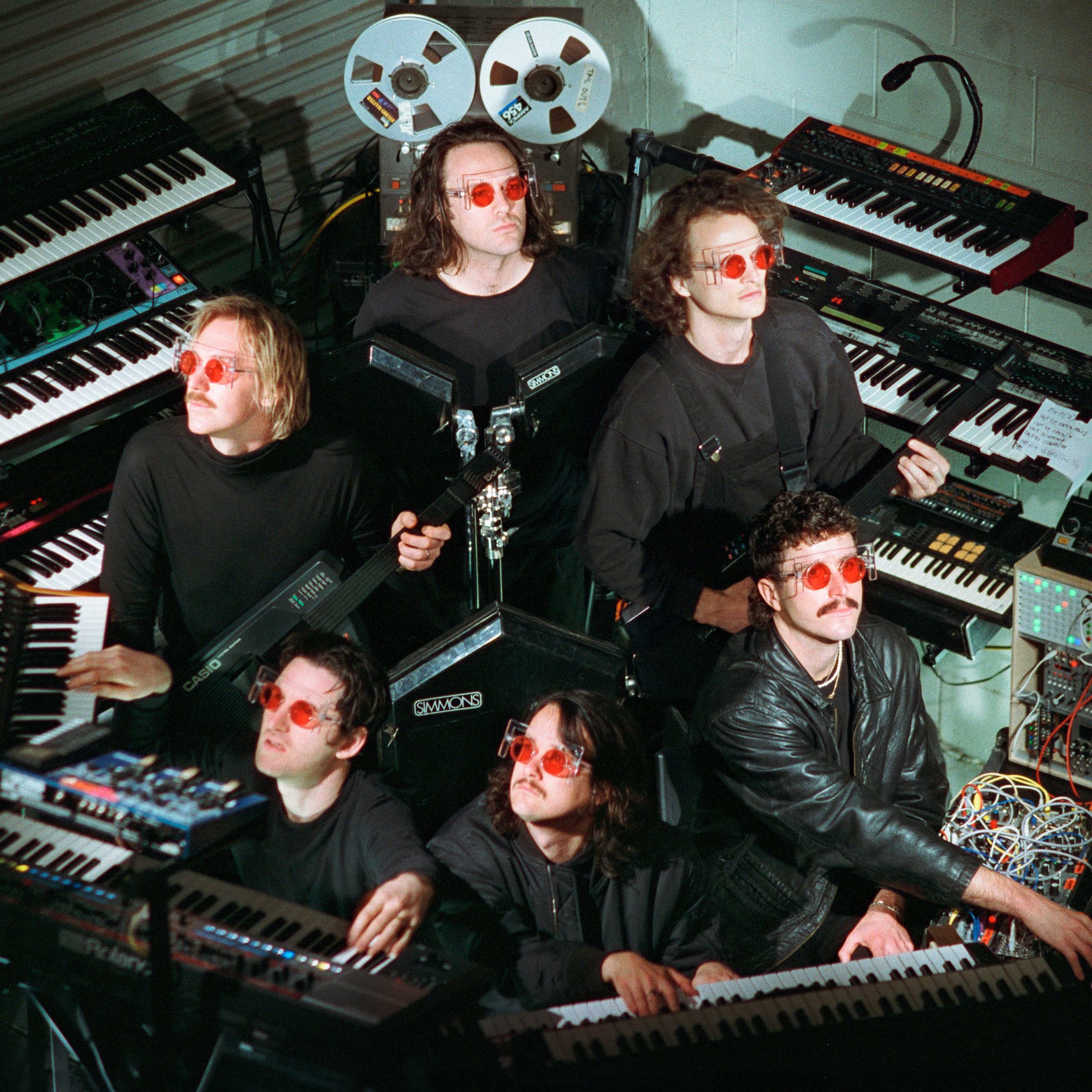
The Silver Cord
—
Out October 27, 2023
—
KGLW



For King Gizzard And The Lizard Wizard, there is no final frontier. Over a decade into their quixotic musical journey, this twelve-legged Antipodean noise machine has taken genres as diverse as Turkish psychedelia, motorik prog, conceptual thrash-metal, bucolic folk-rock, liminal funk, haywire garage-noise and even gonzoid hip-hop and bent each one to their will. As their 25th waxing hovers into view, where next for the world’s most restless, most inventive, most gleefully insatiable group? The answer is suggested by the sleeve to that album, The Silver Cord, depicting the six members of The Gizz surrounded by synthesisers of all shapes and eras. For this is the album where perhaps the most thrilling rock group on the planet turn their hand to Electronic Music.
It all began with an ancient electronic drum kit, purchased on impulse by Gizz’s hirsute rhythm-master, Michael “Cavs” Cavanagh. The Simmons drum-set is an iconic relic of 1980s futurism, its octagonal drum-pads instantly recognisable from music videos of that era. “The Simmons kit is really sick, actually,” grins Stu Mackenzie, Gizzard’s singer/guitarist. “It has this little ‘electronic’ brain all the drum-pads plug into, and while the sounds it can make are pretty rudimentary, we soon decided we wanted to commit to it as the drum sound for this next record. We set Cav’s Simmons kit up in the centre of the room, and then dragged every synth we had in the practice space or lying about our houses into the studio, and plugged everything in. It was chaotic. It was probably the coolest our studio has ever looked, to be honest.”
Longtime Gizz-aficionados will know that The Silver Cord is not the group’s first excursion into the world of wires and oscillators and gadgetry – their 2021 album Butterfly 3000 (their 18th, for all the numerologists in the room) was centred around vintage modular synthesisers and arpeggiators they’d liberated from the world’s junk shops along their travels. But that album’s bugged-out progressive pop suite was an offshoot of necessity, The Gizz using this tech as a means to create an album while they were isolated from each other during the COVID-19 lockdown.
The Silver Cord, by contrast, is a full-hearted and purposeful embrace of electronic equipment and, indeed, electronic music in its own right. It goes without saying that Kraftwerk were an influence, as they are for any artist who picks up a synthesiser. A more keen reference point, however, is the work of Italian composer, producer and synthesiser pioneer Giorgio Moroder, in particular his collaborations with Donna Summer – and particularly in particular, the extended 12” mixes of their tracks together, when the disco anthems channelled their inner motorik inspiration and set the controls of their molten grooves for the heart of the sun.
And it’s here that The Silver Cord does something no King Gizzard album has ever attempted before – becoming an album with a split personality and of divergent possibilities. For The Silver Cord will be available in two incarnations, the first paring these seven tracks back to their hooks, their choruses, their innate pop essence, and respecting the furniture of traditional song form. The second version of the album, however, bulldozes the rules of the three-minute pop hit and lets these cyborg jams run free. The Silver Cord – “Extended Mix” stretches the connecting tissue between each track as far as it can, with Gizz operating as their own disco remixers and exploring the infinite possibilities contained within these extended futurist anthems, building them into astonishing epics unlike anything else in the group’s voluminous catalogue.
“The first version’s really condensed, trimming all the fat,” explains Mackenzie. “And on the second version, that first song, Theia, is 20 minutes long. It’s the ‘everything’ version – those seven songs you’ve already heard on the first version, but with a whole lot of other shit we record while making it. It’s for the heads. I love Donna Summer’s records with Giorgio Moroder, and I’d never listen to the short versions now – I’m one of those people who wants to hear the whole thing. We’re testing the boundaries of people’s attention spans when it comes to listening to music, perhaps – but I’m heavily interested in destroying such concepts.”
The group approached the songwriting for The Silver Cord with the same improv impulse that guided its sister album, the thrash epic PetroDragonic Apocalypse, and the preceding Ice, Death, Planets, Lungs, Mushrooms And Lava. Each day, The Gizz entered the studio and improvised these songs into existence from the ground-up, shaping them from their moments of collaborative, on-the-fly inspiration. The difference from those earlier albums, of course, was the equipment they were using, and the influences they were honouring. “We come at electronic music from an amateur angle,” acknowledges Mackenzie. “I play the Juno synthesiser like a guitar, I don’t really know how to play it. But I wanted to be at peace with being the rock band pretending to know how to use modular synthesisers. We’re in uncharted waters, we’re further out to sea, but leaning into it, we got to a spot where we were really happy with what came out.”
While the futuristic machine music of The Silver Cord is composed and performed on man-made technology, its lyrical themes lean towards that which is beyond man’s ken: the mystic, the infinite and the magical. “It’s metaphysical,” says Mackenzie, “about the spirit, and about life and death, about ancient myths and gods, meditation and astral travelling. I wanted to make lots of disparate connections.”
The fusion of such weighty themes with music that sees The Gizz boldly go where they’ve never gone before is exactly the kind of risky business that is the group’s métier. Their cavalier disregard for safety nets and comfort zones is a defining characteristic, and one that is yielding the best music of their career. And they wouldn’t have it any other way. “It’s liberating to terrify yourself,” Mackenzie grins. “I really believe in that as a philosophy. It’s always been part of our DNA. It’s something we’ve always done, putting ourselves in a position where the cortisol kicks in, pushing ourselves off the bridge and forcing ourselves to swim. Maybe we’ve got the thrill-seeker gene in us or something. It’s definitely my idea of fun.”